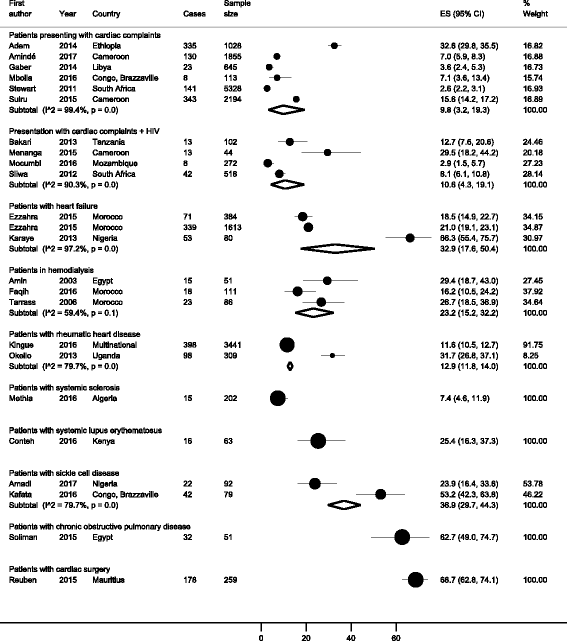Prevalence and etiologies of pulmonary hypertension in Africa: a systematic review and meta-analysis
- PMID: 29221480
- PMCID: PMC5723068
- DOI: 10.1186/s12890-017-0549-5
Prevalence and etiologies of pulmonary hypertension in Africa: a systematic review and meta-analysis
Abstract
Background: Despite the recent increasing worldwide attention towards pulmonary hypertension (PH), its epidemiology remains poorly described in Africa. Accordingly, we performed a systematic review and meta-analysis of PH prevalence, incidence and etiologies in Africa.
Methods: We searched PubMed, EMBASE, African Journals Online, and Africa Index Medicus. Published observational studies until September 20, 2017, including adult participants residing in Africa were considered. Two review authors independently selected studies, assessed included studies for methodological quality, and extracted data. A random-effects model was used for meta-analysis. Heterogeneity was evaluated by the χ 2 test on Cochrane's Q statistic which is quantified by I2 values. Using Newcastle-Ottawa Scale, we considered a score of 0-4, 5-7, and 8-10 as indicative of high, moderate, and low risk of bias in included studies, respectively.
Results: Of 1611 entries, 25 studies were retained. Twelve (48%), seven (28%), and six (24%) papers had respectively a low, moderate and high risk of bias. The prevalence of PH widely varied across different populations: 9.8% (95% confidence interval: 3.2-19.3; I2 = 99.4%; 6 studies) in 11,163 people presenting with cardiac complaints; 10.6% (4.3-19.1; I2 = 90.3%; 4 studies) in 937 HIV-infected people; 32.9% (17.6-50.4; I2 = 97.2%; 3 studies) in 2077 patients with heart failure; 23.2% (15.2-32.2; I2 = 59.4%; 3 studies) in 248 patients on hemodialysis; 12.9% (11.8-14.0; I2 = 79.7%; 2 studies) in 3750 patients with rheumatic heart disease; 36.9% (29.7-44.3; I2 = 79.7; 2 studies) in 79 patients with sickle cell disease; 62.7% (49.0-74.7; 1 study) in 51 patients with chronic obstructive pulmonary disease; 25.4% (16.3-37.3; 1 study) in 63 patients with systemic lupus erythematous; 68.7% (62.8-74.1; 1 study) in 259 patients with cardiac surgery; and 7.4% (4.6-11.9; 1 study) in 202 patients with systemic sclerosis. No study reported PH incidence. From one international study (n = 209), PH etiologies were: left heart disease (68.9%), pulmonary arterial hypertension (15.8%), lung disease and/or hypoxia (12.0%), chronic thromboembolic PH (1.9%) and unclear/multifactorial PH (15.8%).
Conclusion: The prevalence of PH is relatively high in some populations in Africa, perhaps mainly driven by left heart diseases, highlighting the need for context-specific interventions.
Keywords: Africa; Epidemiology; Meta-analysis; Pulmonary arterial hypertension; Pulmonary hypertension; Systematic review.
Conflict of interest statement
Ethics approval and consent to participate
Not applicable.
Consent for publication
Not applicable.
Competing interests
The authors declare that they have no competing interests.
Publisher’s Note
Springer Nature remains neutral with regard to jurisdictional claims in published maps and institutional affiliations.
Figures
Similar articles
-
Prevalence of chronic obstructive pulmonary disease in the global population with HIV: a systematic review and meta-analysis.Lancet Glob Health. 2018 Feb;6(2):e193-e202. doi: 10.1016/S2214-109X(17)30451-5. Epub 2017 Dec 16. Lancet Glob Health. 2018. PMID: 29254748
-
Systemic pharmacological treatments for chronic plaque psoriasis: a network meta-analysis.Cochrane Database Syst Rev. 2021 Apr 19;4(4):CD011535. doi: 10.1002/14651858.CD011535.pub4. Cochrane Database Syst Rev. 2021. Update in: Cochrane Database Syst Rev. 2022 May 23;5:CD011535. doi: 10.1002/14651858.CD011535.pub5. PMID: 33871055 Free PMC article. Updated.
-
Prevalence and incidence of pulmonary hypertension among HIV-infected people in Africa: a systematic review and meta-analysis.BMJ Open. 2016 Aug 23;6(8):e011921. doi: 10.1136/bmjopen-2016-011921. BMJ Open. 2016. PMID: 27554104 Free PMC article.
-
Doppler trans-thoracic echocardiography for detection of pulmonary hypertension in adults.Cochrane Database Syst Rev. 2022 May 9;5(5):CD012809. doi: 10.1002/14651858.CD012809.pub2. Cochrane Database Syst Rev. 2022. PMID: 35532166 Free PMC article.
-
Computer and mobile technology interventions for self-management in chronic obstructive pulmonary disease.Cochrane Database Syst Rev. 2017 May 23;5(5):CD011425. doi: 10.1002/14651858.CD011425.pub2. Cochrane Database Syst Rev. 2017. PMID: 28535331 Free PMC article.
Cited by
-
Pulmonary hypertension in developing countries: Limiting factors in time to diagnosis, specialised medications and contextualised recommendations.Afr J Thorac Crit Care Med. 2022 May 5;28(1):10.7196/AJTCCM.2022.v28i1.176. doi: 10.7196/AJTCCM.2022.v28i1.176. eCollection 2022. Afr J Thorac Crit Care Med. 2022. PMID: 35891681 Free PMC article. Review.
-
Neglected cardiovascular diseases and their significance in the Global North.Herz. 2021 Mar;46(2):129-137. doi: 10.1007/s00059-021-05020-7. Epub 2021 Jan 27. Herz. 2021. PMID: 33506326 Review. English.
-
Patient characteristics and cardiac surgical outcomes at a tertiary care hospital in Kenya, 2008-2017: a retrospective study.PeerJ. 2021 May 10;9:e11191. doi: 10.7717/peerj.11191. eCollection 2021. PeerJ. 2021. PMID: 34026344 Free PMC article.
-
A call for strengthened evidence on targeted, non-pharmaceutical interventions against COVID-19 for the protection of vulnerable individuals in sub-Saharan Africa.Int J Infect Dis. 2020 Oct;99:482-484. doi: 10.1016/j.ijid.2020.08.060. Epub 2020 Aug 27. Int J Infect Dis. 2020. PMID: 32861825 Free PMC article.
-
Pulmonary hypertension among patients hospitalized with acute heart failure in Buea, South West Region of Cameroon.Pan Afr Med J. 2022 Jul 20;42:216. doi: 10.11604/pamj.2022.42.216.33076. eCollection 2022. Pan Afr Med J. 2022. PMID: 36845244 Free PMC article.
References
-
- Galie N, Humbert M, Vachiery JL, Gibbs S, Lang I, Torbicki A, Simonneau G, Peacock A, Vonk Noordegraaf A, Beghetti M, et al. 2015 ESC/ERS guidelines for the diagnosis and treatment of pulmonary hypertension: the joint task force for the diagnosis and treatment of pulmonary hypertension of the European Society of Cardiology (ESC) and the European Respiratory Society (ERS): endorsed by: Association for European Paediatric and Congenital Cardiology (AEPC), International Society for Heart and Lung Transplantation (ISHLT) Eur Respir J. 2015;46(4):903–975. doi: 10.1183/13993003.01032-2015. - DOI - PubMed
-
- Tueller C, Stricker H, Soccal P, Tamm M, Aubert JD, Maggiorini M, Zwahlen M, Nicod L. Epidemiology of pulmonary hypertension: new data from the Swiss registry. Swiss Med Wkly. 2008;138(25–26):379–384. - PubMed
-
- D’Alonzo GE, Barst RJ, Ayres SM, Bergofsky EH, Brundage BH, Detre KM, Fishman AP, Goldring RM, Groves BM, Kernis JT, et al. Survival in patients with primary pulmonary hypertension. Results from a national prospective registry. Ann Intern Med. 1991;115(5):343–349. doi: 10.7326/0003-4819-115-5-343. - DOI - PubMed
Publication types
MeSH terms
LinkOut - more resources
Full Text Sources
Other Literature Sources
Medical
Molecular Biology Databases



